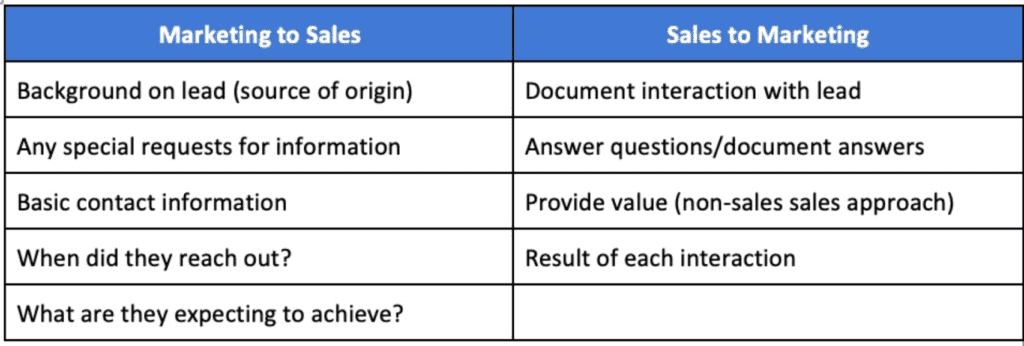Connecting marketing to sales remains a challenge for firms in all industries and sizes. For smaller MSPs and VARs with small or outsourced marketing teams, it poses an even greater challenge: how to get the right information flowing between both groups so leads don’t grow cold.
Most firms create a chart highlighting the information needed to move forward. Here’s an example for MSPs and VARs:

Based on this chart, you’ll need to think through a few things to ensure leads don’t grow cold once they enter your marketing and sales ecosystem. When marketing and sales work together well for an MSP or VAR business, web visitors flow from leads to brand advocates in record time, shortening your sales cycle and speeding your revenue growth. Here are a few things to consider as you align sales and marketing for your firm.
Think Through the Information Flow

First, you’ll want to be aware of the information each group (sales and marketing) needs to move the lead through the sales funnel. To do this, you’ll need to:
- Meet with each group individually and then together.
- During the individual sessions, simply ask what’s needed to handle the lead quickly and with actions that have a high likelihood of moving the lead to conversion.
- When you meet as a group, confirm and compile your findings, ironing out the kinks – ensuring both groups are on the same page and know what to expect
- Create a simple written document, similar to the table above, listing out which group does what (and when they’ll do it).
With this kind of clarity, you have a chance to track results and improve on them, to boost conversions and shorten the sales cycle.
What Is Marketing Providing to Sales?

When a visitor downloads a content offer, signs up for your blog, or fills out a contact form, that shows the person is somewhat engaged with your brand. With proper lead scoring, you’ll be able to determine what actually makes a lead “marketing qualified.” That can sometimes mean the person has visited more than five pages (and has stayed on those pages for more than a few minutes, indicating they’ve read the content), or it could mean they’ve downloaded several of your content offers.
Whatever your criteria for turning a visitor into a marketing qualified lead, the information you gather during the initial stages is critical to the success of your engagement with your online lead.
Information marketing should be gathering in anticipation of a sale includes comprehensive contact information, aside from the basics such as first name, last name, email address. A few other items to consider collecting include:
- What the lead’s needs are
- When they’re looking to move forward with a solution
- What their biggest pain point is
- The size of their team or organization
- Whether or not they have budget authority
You may be concerned about collecting this much specific information would send a lead running. Sometimes that’s the case, and sometimes these are welcome questions that help the lead think through their needs prior to moving forward with your business. Asking the right questions on a form prior to giving access to a valuable content offer may provide the turning point in qualifying a lead that’s worth the time of your sales team.
Note: Consider holding off on in-depth questions for your “lighter” content offers and use them for your heavy-hitting, high-value offers that could be game-changers for your ideal customer. Your leads will jump through as many hoops as necessary to get to solid content offers. That’s why you want to:
- Clearly define who your ideal customer is
- Provide solid information that solves a key problem for them in your content offer
- Develop more than one powerful content offer to show you have expertise in key areas of your business.
This all gives you the right to ask pointed questions as you move the lead from simply a visitor to marketing-qualified and then sales-qualified.
What’s Sales Providing to Marketing?

Some may wonder what role sales plays in information gathering during the sales cycle. After all, by the time the lead gets to them, it’s conversion time, not note-taking time. Nothing could be further from the truth. If done well, marketing qualification makes the chances of a sales conversion much higher. Yet during the sales process, we want to turn our eyes to brand advocacy. That process starts during the final stages of conversion.
A few points to consider:
- Provide non-sales sales materials provided by your marketing team such as exclusive white papers, email templates, and other helpful tools that make your lead’s life easier. They’ll remember these kinds of interactions and tell others in the industry about the quality of your firm.
- To make the marketing qualification process better, it’s important for sales to provide feedback on what’s happening once the lead is in their area. Answer questions for marketing such as:
– Are they asking for more data?
– Is the information provided correct?
– Are they looking for a specific solution or a comprehensive suite of solutions that covers their entire organization?
- Many times, this information can only come during the sales qualification stage, but when marketing has a heads-up about what leads are asking, they can create content that answers those questions up front, making the sales cycle even shorter. This also makes the sales process more of a conversation than an information exchange.
When this process begins to yield results, both sides become even more open to information sharing and develop a stronger commitment to accurate lead identification and conversion. There’s one tool that makes this process a breeze.
Marketing Automation Connects Marketing and Sales to Speed Lead Conversion

For some firms, this may seem daunting. With a solid marketing automation system, it’s quite doable. Marketing automation systems facilitate proper lead scoring, integrate with your CRM tool, and prompt users to collect information at the right stages in the sales cycle – plus much more. With a commitment to using the system, MSPs and VARs can ensure leads don’t grow cold due to a disconnect between marketing and sales.
Point to consider: Work with an agency that understands the IT channel, partner marketing, digital, and overall vendor engagements. With a qualified marketing partner by your side, you can achieve the results you’ve often dreamed of. Let’s have a conversation about next steps.